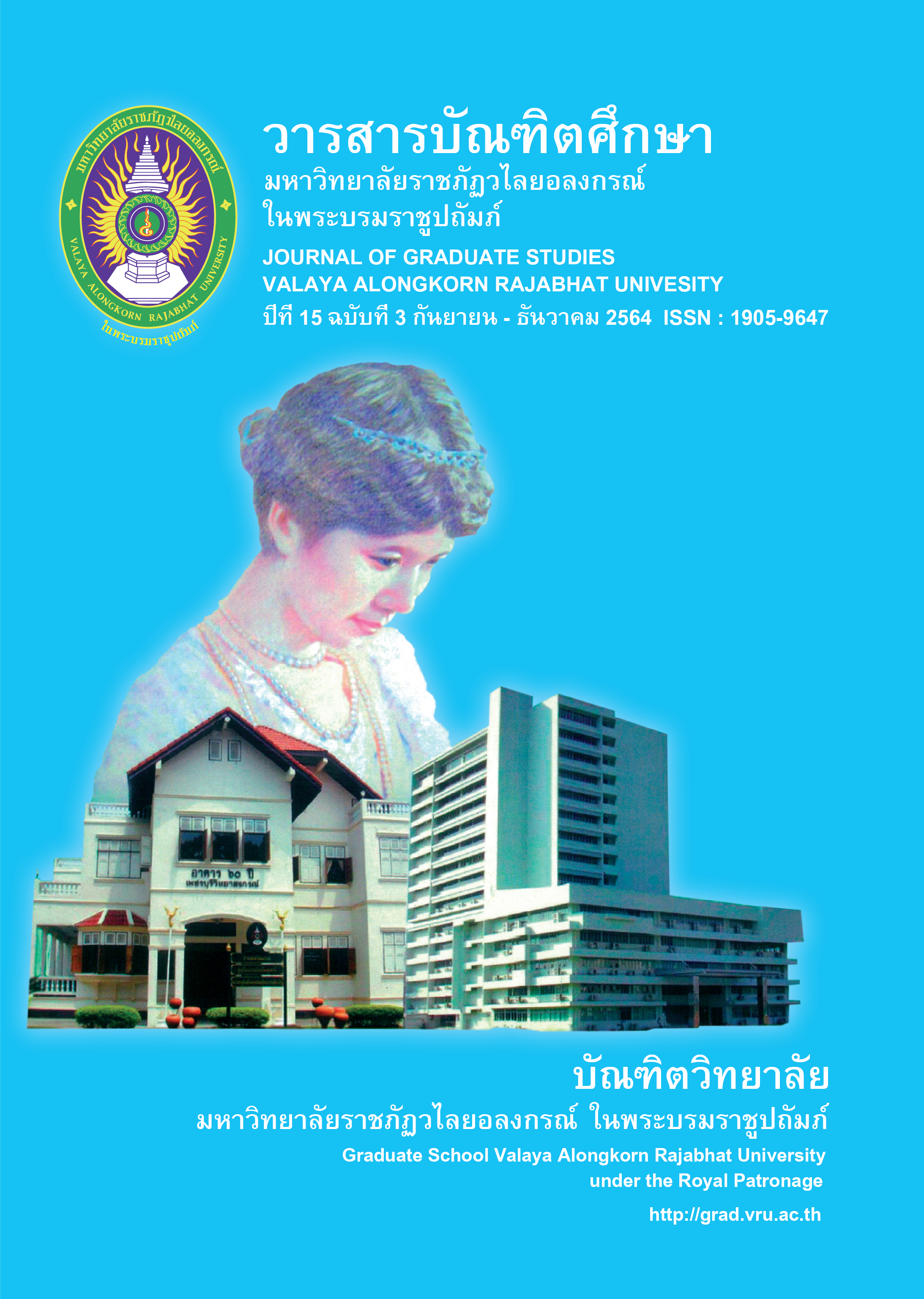ADVERSITY QUOTIENT OF STUDENTS OF FACULTY OF EDUCATION, VALAYA ALONGKORN RAJABHAT UNIVERSITY UNDER THE ROYAL PATRONAGE
Main Article Content
Abstract
The purposes of this research article were to (1) study the adversity quotient of students of the faculty of education, Valaya Alongkorn Rajabhat University under the Royal Patronage, and 2) compare the adversity quotient of students of the faculty of education, Valaya Alongkorn Rajabhat University under the Royal Patronage by gender, group of major and year level. Samples were 284 students by stratified random sampling. Research instrument was a 4 -point scale with Cronbach’s alpha reliability of 0.90. Data were analyzed by descriptive statistics methods including frequency, percentage, means and standard deviation and by inferential statistics methods of t-test for independent samples and F-test for one – way Analysis of Variance: ANOVA.
The research findings were as follows: 1) The students had a quite high level of adversity quotient in overall by aspect in Responsibility for the Problem with the highest mean scores, followed by aspect in Situation Control, Endurance, and Reach, respectively (2) The result of comparison the means of the students' adversity quotient when classified by group of major and year level, showed no difference. When classified by gender, it was found that, overall, females had higher adversity quotient than males with statistically significant at the .05 level.
Article Details

This work is licensed under a Creative Commons Attribution-NonCommercial-NoDerivatives 4.0 International License.
บทความทุกเรื่องได้รับการตรวจความถูกต้องทางวิชาการโดยผู้ทรงคุณวุฒิ ทรรศนะและข้อคิดเห็นในบทความ Journal of Global of Perspectives in Humanities and Social Sciences (J-GPHSS) มิใช่เป็นทรรศนะและความคิดของผู้จัดทำจึงมิใช่ความรับผิดชอบของบัณฑิตวิทยาลัย มหาวิทยาลัยราชภัฏวไลยอลงกรณ์ ในพระบรมราชูปถัมภ์ กองบรรณาธิการไม่สงวนสิทธิ์การคัดลอก แต่ให้อ้างอิงแหล่งที่มา
References
Best, J. W. (1970). Research in Education. New Jersey: Prentice Hall, Inc.
Cohen, J. (1977). Statistical power for the behavioral sciences. 2nd ed. New York: Academic Press.
Danpradit, B. and Sontrirat, S. (2015). kānkam kap tonʻēng khwāmsāmāt nai kān phachœ̄n læ fanfā ʻuppasak rǣng čhūngčhai phāinai læ khwāmsamret nai kān rīan khō̜ng nisit chanpa u thī sō̜ng mahāwitthayālai kasētsāt witthayākhēt bāng khēn [Self-regulation, adversity quotient, intrinsic motivation and academic success of sophomores at kasetsart university, bangKhen campus]. Journal of Soc Sci & Hum, 41(1), 121-134.
Kambannarak, T. (2005). AQ ʻưt kœ̄n phikat [Adversity quotient]. Bangkok: Explorer Net.
Kanjanawasee, S. (2005). thritsadī kānthotsō̜p bǣp dangdœ̄m [Classical test theory]. Bangkok: Chulalongkorn University.
Kantitammakool, A. (2009). khwāmsāmāt nai kān phachœ̄n panhā læ fāfan ʻuppasak khō̜ng naksưksā mahāwitthayālai sī pathum witthayākhēt Chon Burī tām thritsadī khō̜ng sō̜tō̜lot [Sripatum university-chonburi campus students’ adversity quotient according to stoltz’s theory]. Sripatum Chonburi Journal. 6(1), 49-55.
Nunnally, J. (1967). Psychometric theory. New York: McGraw-Hill.
Sornrak, L. (2013). khwāmsāmāt nai kān phachœ̄n panhā læ fanfā ʻuppasak kap phon samrit thāngkān rīan wichā sathiti thurakit bǣp phasomphasān khō̜ng naksưksā khana banchī mahāwitthayālai krung thēp [Adversity quotient and students’ learning achievement in business statistics taught through hybrid learning pattern: the case of accounting students bangkok university]. HCU Journal, 17(33), 17-35.
Stoltz, P. G. (1997). Adversity quotient: turning obstacles into opportunities. New York: John Wiley & Sons.
Woolfolk, A. (2004). Education psychology. 9th ed. Boston: Pearson.


